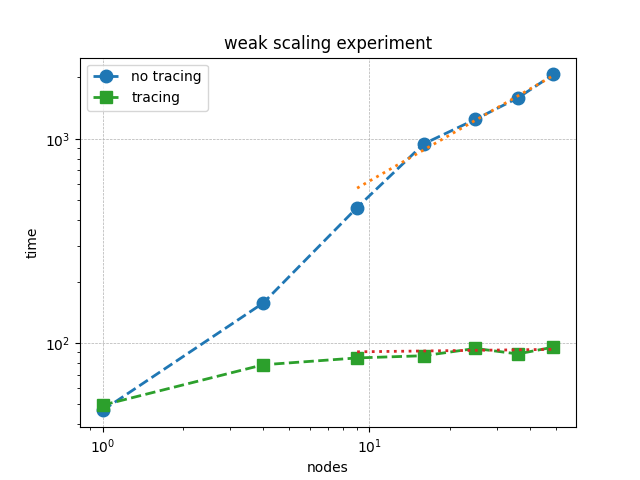Tracing
The overhead of Legion’s dependency analysis can be greatly reduced by annotating sequences of tasks that are executed repeatedly on the same fields.
This is a weak scaling plot of Red-Black Gauss-Seidel iteration for Poisson’s Equation in 2D. The blue circles are the weak scaling results without tracing and green squares are with tracing. Already at fifty nodes there is a 20X performance difference. The solution time without tracing scales as \(\left(\texttt{nodes}\right)^{0.7}\). So this difference will only get worse.

Implementing Tracing in Your Code
Here is the iteration loop without tracing.
using namespace flecsi;
std::size_t sub{3};
std::size_t ita{0};
do {
for(std::size_t i{0}; i < sub; ++i) {
s.execute<task::red>(m, ud(m), fd(m));
s.execute<task::black>(m, ud(m), fd(m));
}
ita += sub;
s.execute<task::discrete_operator>(m, ud(m), Aud(m));
auto residual = s.reduce<task::diff, exec::fold::sum>(m, fd(m), Aud(m));
s.execute<task::print_residual>(residual, ita+sub);
} while(ita < max_iterations.value());
Note
Residual tolerance termination conditions are usually employed for solvers, but FleCSI does not yet support futures in this way.
Note
These loops contain execute<> task launches. Any such loops in your code
need to have tracing enabled either on the loop itself or on a containing loop.
using namespace flecsi;
std::size_t sub{3};
std::size_t ita{0};
static exec::trace t; // trace object
t.skip(); // skip tracing first time through loop
do {
auto g = t.make_guard(); // turn tracing on for enclosing do loop
for(std::size_t i{0}; i < sub; ++i) {
s.execute<task::red>(m, ud(m), fd(m));
s.execute<task::black>(m, ud(m), fd(m));
}
ita += sub;
s.execute<task::discrete_operator>(m, ud(m), Aud(m));
auto residual = s.reduce<task::diff, exec::fold::sum>(m, fd(m), Aud(m));
s.execute<task::print_residual>(residual, ita+sub);
} while(ita < max_iterations.value());
Note
The first time through this loop, task::red follows
initialization tasks. This can setup a different ghost copy pattern
than all other iterations. Tracing works by replaying memoized dependency analysis
computations. The t.skip() command tells FleCSI to defer tracing
until the second iteration of the do loop.
When to Use Tracing
You should enable tracing anytime you have a set of tasks that will be execute<>’ed in the same sequence over and over again.